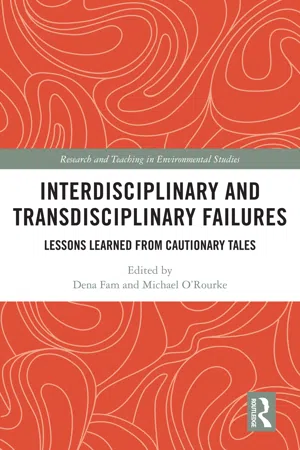
Interdisciplinary and Transdisciplinary Failures
Lessons Learned from Cautionary Tales
- 288 pages
- English
- ePUB (mobile friendly)
- Available on iOS & Android
Interdisciplinary and Transdisciplinary Failures
Lessons Learned from Cautionary Tales
About This Book
Unlike other volumes in the current literature, this book provides insight for interdisciplinary and transdisciplinary researchers and practitioners on what doesn't work. Documenting detailed case studies of project failure matters, not only as an illustration of experienced challenges but also as projects do not always follow step-by-step protocols of preconceived and theorised processes.
Bookended by a framing introduction by the editors and a conclusion written by Julie Thompson Klein, each chapter ends with a reflexive section that synthesizes lessons learned and key take-away points for the reader. Drawing on a wide range of international case studies and with a strong environmental thread throughout, the book reveals a range of failure scenarios for interdisciplinary and transdisciplinary projects, including:
• Projects that did not get off the ground;
• Projects that did not have the correct personnel for specified objectives;
• Projects that did not reach their original objectives but met other objectives;
• Projects that failed to anticipate important differences among collaborators.
Illustrating causal links in real life projects, this volume will be of significant relevance to scholars and practitioners looking to overcome the challenges of conducting interdisciplinary and transdisciplinary research.
Frequently asked questions
Information
1 Theoretical and empirical perspectives on failure
Introduction
What is failure?
Ways of thinking about failure
- 1. “a state where reality is inferior to the goal”; “reality is worse than expectations” (Lee and Miesing 2017, p. 159)
- 2. “deviation from expected and desired results” (Cannon and Edmondson 2005, p. 300)
- 3. “an unacceptable difference between expected and observed performance” (Carper 1996, p. 57, as quoted in Petroski 2018, p. 50)
- 4. Education: “students will typically not be able to generate or discover the correct solution(s) by themselves” (Kapur 2016, p. 289)
- 5. Academia: “the authoring faculty members’ inability to collaboratively create our intended, idealized manuscript product in a timely fashion” (Vanasupa et al. 2011, p. 173)
Disciplinary perspectives on failure
- Engineering: Because the failure of bridges or structures can lead to injury and death, it is incumbent on engineers to design with failure in mind. Engineering is in fact home to forensic engineering, or the investigation of engineering failures, and failure analys...
Table of contents
- Cover
- Half-Title
- Series
- Title
- Copyright
- Contents
- List of figures
- List of tables
- List of contributors
- Preface
- Acknowledgements
- 1 Theoretical and empirical perspectives on failure: An introduction
- 2 Re-thinking failure: Using design science theory and methods, including design-thinking, for successful transdisciplinary health and social interventions
- PART I Institutional environments associated with failure
- PART II Failures and responses associated with collaboration and stakeholder engagement
- PART III Personal reflection on failed initiatives through an autoethnographic lens
- PART IV Failure in interdisciplinary and transdisciplinary educational programs
- Coda
- Index